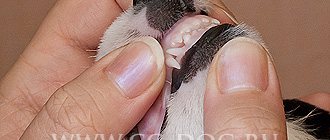In Russia, calls to castrate pets have not yet received a response. This is probably why we still have so many homeless animals. But that’s not about that now. There are situations when a veterinarian insists on castration not for ethical reasons, but for medical reasons. What if the dog is already over 10 years old at this point? What if the doctor is wrong and castration is not needed?
Chemical castration of a male dog is an alternative to surgery. However, there are reasons why it has not entered into mass practice and is rarely used. Let's consider the pros and cons of this procedure.
Comics were drawn to order especially for this article. They will help you understand how chemical castration of a male dog occurs, even if you do not understand medicine.
Author of the article: Olga Shiltsova, practicing veterinarian, author of the books “Dachshund of Fate” and “Tails of Fortune”
What drug is used for chemical castration of a male dog?
There are drops and tablets that are used for short-term suppression of sexual desire in males. These are drugs such as Stop-intim, Sex-barrier and others. They basically contain female sex hormones. They are not related to chemical castration.
Chemical castration involves the introduction of a Suprelorin implant under the skin. The tiny hard capsule is made up of fatty substances. Gradually dissolving in the body, it releases deslorelin. It is a synthetic analogue of gonadotropin-releasing hormone (GnRH).
How Suprelorin works - in simple words
Gonadotropin is not a sex hormone; it is one level higher. This is why Suprelorin causes temporary sterilization in both males and females. To understand this mechanism, let's look at how sexual function is regulated in dogs.
All hormones in the body are controlled by the pituitary gland, a gland in the brain. And the pituitary gland, in turn, obeys the hypothalamus. It is the hypothalamus that produces gonadotropin-releasing hormone (GnRH). GnRH instructs the pituitary gland to produce follicle-stimulating and luteinizing hormones (FSH and LH). And they already affect the sex glands.
In males, LH causes the production of testosterone, and FSH stimulates the production of sperm in the testes.
The active ingredient in Suprelorin, deslorelin, is a synthetic GnRH agonist. Deslorelin acts on the pituitary gland by blocking its receptors for the effects of GnRH. The synthetic hormone is much more active than the natural one, therefore, when Suprelorin is first administered, a rapid release of LH and FSH occurs, and testosterone levels increase.
After a short period (1-2 weeks) of stimulation, the production of LH and FSH in the pituitary gland stops, and the testes are no longer commanded to produce sperm and testosterone. Over time, the testicles decrease in size by 2-3 times.
And now again - with pictures:
Testosterone levels decrease gradually. A male dog is considered capable of breeding within 6 weeks after the first administration of Suprelorin. After 1.5 months, even being kept with females in heat does not cause sexual arousal or attempts to mate.
The duration of action of the implant depends on the dose. When using Suprelorin 4.7 mg, the guaranteed period of infertility lasts 6 months. For permanent suppression of sexual function, injections are given every six months. But in small breeds (up to 10 kg), the decrease in libido can last 1 year or more.
An implant with a dosage of 9.4 mg is administered once a year.
How the procedure works
The use of Suprelorin is reminiscent of the procedure for microchipping dogs. The capsule is located inside a thick needle, which is attached to a pusher syringe.
Suprelorin: implant and syringe pusher
No anesthesia is required, although some doctors prefer to numb the area of skin before insertion (2% lidocaine is most often used). In dogs with dense coats, the injection site is shaved.
The skin is pierced and the needle is inserted the entire length into the subcutaneous space. Only after this the doctor presses the piston and installs the hormonal chip. If the dog is active and the hole left after the puncture is large, it makes sense to put one suture so that the capsule is guaranteed not to pop out. Or use medical glue.
The implant is declared as biocompatible. Over time, it should completely dissolve in the body. But sometimes a capsule of connective tissue forms at the injection site, and a tubercle remains that can be felt.
Interestingly, even if the implant is damaged (for example, during a fight), the drug will continue to work. The active substance is distributed evenly throughout the capsule, it does not matter whether it remains whole or breaks into two halves.
Why is sterilization necessary?
Expert opinion
Anna Abramenko
An avid dog lover. Experience in veterinary medicine since 2009.
Ask a Question
Surgical intervention in a dog’s sexual life can be an urgent social need. Every year there are more and more homeless animals on the street, which can be reduced through sterilization.
The owner of the girl, unless we are talking about breeding individuals and high-quality pedigree, is not interested in permanent offspring. Puppies need to find a home, and maintaining a pregnant female and a dog with a newborn litter is much more expensive than paying money for a procedure at the clinic one time.
Benefits of Chemical Castration
Using a hormonal implant instead of surgery may seem like a very tempting option. Suprelorin has a number of undeniable advantages:
Reversible action
After the end of the implant's effect or after its forced removal, sexual function is completely restored. This may take varying amounts of time, on average 1-3 months. Even if a male dog has been under the influence of Suprelorin for several years, the testes will return to normal after the drug wears off.
Removing the implant
There are no operational risks
The most compelling reason to choose chemical castration over traditional castration is the presence of contraindications for the operation:
- heart disease;
- diabetes;
- poor blood clotting (for example, with congenital pathology);
- malignant hyperthermia;
- sensitivity to drugs;
- brachiocephalic syndrome.
For a qualified anesthesiologist, there are practically no absolute contraindications to anesthesia. But one can also understand the owners who do not want to take risks. After all, there are cases when a young and apparently healthy animal dies during a planned surgical intervention. Even though such cases are one in ten thousand, there is always a certain risk.
Castration of a male dog is an operation performed under general anesthesia.
If your veterinarian is wary of putting your pet under anesthesia for neutering, Suprelorin may be an alternative solution. Detailed information about surgical castration of a male dog is HERE (the article will open in a new tab).
No side effects
During a safety study of the drug, 10 implants were administered simultaneously to dogs, but no side effects associated with overdose were noted. Suprelorin does not depress the testes, it acts on the hypothalamus. Deslorelin does not cause any complications in males, unlike many hormonal drugs that are used to stop estrus in females.
In what cases is castration necessary?
The decision to sterilize or castrate dogs is by no means a whim of the dog owner, it is a vital necessity, because this procedure, one might say, prolongs the animal’s “childhood” age. The dog behaves appropriately, calmly, does not run after the object of desire when spring comes and does not mark its territory.
Castration is advisable in cases where:
It is not planned to obtain offspring from the dog for breeding.
The participation of male dogs in exhibitions is not provided, since the exhibition is a selection of producers, and castrated individuals are considered defective.
The dog becomes too aggressive and uncontrollable.
The animal tries to dominate behavior, and this is dangerous, especially if there are small children in the house.
For preventive purposes to prevent diseases of the genitourinary system (castrated individuals suffer from them much less often).
For an experienced veterinarian, castration is a routine procedure. However, you need to understand that, like any other surgical intervention, it is associated with certain risks: infection, suppuration of the incision, swelling and other unpleasant complications. In addition, not all animals, for health reasons or for some other reasons, are suitable for the traditional method, so veterinary clinics can offer dog breeders alternative methods, one of which is chemical castration in dogs.
Indications for chemical castration of male dogs
The indications for chemical castration are exactly the same as for traditional castration. This is the prevention of uncontrolled reproduction of dogs and the suppression of sexual desire - and related problems.
If the owner does not plan offspring from this dog (never and under any circumstances), then surgery is preferable. If the problem is different, it makes sense to consider the introduction of “Suprelorin” as an alternative.
Behavioral problems
Castration of male dogs is often recommended as a remedy for aggression. But if a dog growls at children, bites owners, or lunges at relatives during a walk, this is not always associated with the reproductive instinct. Most often this is a task for the dog handler, and castration will not solve the problem. You can check this with the help of Suprelorin. If, after installing the chip, aggression decreases or disappears, the operation makes sense.
The same goes for indoor tagging. Castration most often helps to get rid of annoying peeing in the apartment. But as the owners of some stubborn dogs rightly note, sometimes a male dog neutered in adulthood continues to wet the corner of the sofa, either out of spite or out of habit. If it is difficult for owners to decide on a traditional operation, they resort to chemical castration.
I was told that we were going to the clinic for castration, but it seems my “guys” are still there!
Alopecia X
Baldness in a dog, the cause of which is not clear, is called the beautiful term “alopecia X”. This problem occurs in certain dog breeds, such as Spitz, Chow Chow, and Malamute. The guard hairs fall out and a soft undercoat remains. And then the skin becomes smooth. No anxiety or itching is observed.
One of the reasons for such baldness is problems with sex hormones. The first thing a dermatologist recommends is castration. This really helps most dogs and their fur returns as if by magic. Therefore, alopecia X in some sources is called alopecia “treatable by sterilization.”
It is difficult for owners to understand how the testes and hair loss in their dog are related. It’s difficult to decide on such an operation - what if we cut it off in vain? Such a patient should have a Suprelorin chip installed. If the dog begins to grow overgrown, he will later be surgically castrated. If not, look for another cause of alopecia.
Pomeranian Spitz, diagnosed with alopecia X, castration recommended
Prostate hyperplasia
Prostatitis is more common in older male dogs. It happens that it is too risky to operate on such a patient due to heart or kidney problems or concomitant diseases such as diabetes. Then prostate hyperplasia is treated with medication, after which the dog is prescribed Suprelorin for life.
Stimulation of sexual activity
It is a paradox to administer a castration drug to stimulate the stud dog. But the implant acts in such a way that in the first two weeks after insertion, the concentration of sex hormones, on the contrary, goes through the roof. Breeders use Suprelorin when they need to increase the activity of a dog and carry out a series of matings. Then the chip is left or removed - at the request of the owners.
"Test" castration
Veterinarians never tire of repeating that castration does not harm the dog’s working qualities. But the owner has the right to make sure of this before taking the dog for surgery. Suprelorin is given to herding, hunting, guard and working dogs to see if decreased libido will prevent them from performing work as well as before.
Shared keeping of dogs in kennels
Suprelorin is often used by professional breeders. Let's say there are two breeding dogs and four bitches in a house. And the breeder wants to use only one of them for mating. What should the other one do when the ladies go into heat? Just climb the wall, pee on everything around and refuse to eat. If you use Suprelorin, both the dog and the owners can live in peace. And after the end of the implant, this male can be used for mating in the kennel or outside.
Guess. Which of them is under the influence of Suprelorin?
Or there is a stud dog of one breed and a bitch of another at home. Surgical castration is not advisable because you want to use him for breeding. In this case, you can use Suprelorin while the bitch is fertile and stop inserting implants after she is spayed.
For those who think that “they won’t succeed anyway,” I suggest you admire the Dachshund and Labrador mix HERE (link will open in a new tab).
What is sterilization
Surgical intervention in the reproductive function of a dog to suppress sexual desire and completely stop the reproductive organs is a sterilization procedure.
There are several types and methods of performing the operation:
- Cavity. Most common among veterinarians. Opening the dog's abdominal cavity occurs under general anesthesia. The duration of the procedure itself is no more than one and a half hours, then the animal will have a long period of rehabilitation.
- Laparoscopy method. Suitable only for small dogs that weigh no more than 10 kg. Through mini-punctures, the doctor enters the abdominal cavity with minimal trauma to the animal. The recovery period passes quickly.
- Chemical. It involves sterilization by injection or injection, which is given to a dog up to one year old. This method is not recommended by experienced veterinarians, as there is a high risk of developing abdominal diseases and tumors.
- Partial method. It is used in relation to young dogs that have not yet given birth to their first offspring. Only the ovaries are removed, not the uterus.
- Tubal occlusion. All organs remain in place, and the female’s fallopian tubes are ligated. This method will only prevent the dog from unwanted pregnancy, but will not stop estrus and uncontrollable behavior caused by the instinct to procreate.
Expert opinion
Anna Abramenko
An avid dog lover. Experience in veterinary medicine since 2009.
Ask a Question
Seamless methods are easier for dogs to tolerate and wear out their bodies less than abdominal surgery.











